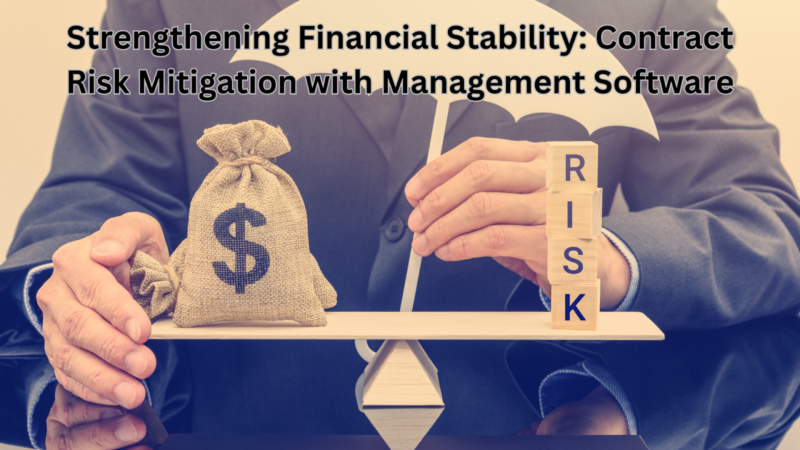Ensuring financial stability in the face of dynamic market conditions and regulatory pressures is crucial in the finance realm. Particularly, managing contract risks effectively stands as a cornerstone for maintaining financial stability. However, traditional contract management methods often fall short of addressing the complexities and evolving nature of the risk factors inherent in financial agreements. Consequently, there is a pressing need for innovative solutions to mitigate contract risks and fortify financial stability.
This article delves into the pivotal role of management software in bolstering financial stability through contract risk mitigation. By leveraging cutting-edge software solutions tailored to financial contracts’ intricacies, institutions can proactively identify, assess, and mitigate potential risks. Such software empowers financial entities to streamline contract processes, enhance transparency, and enforce compliance automation with regulatory standards.

Furthermore, the utilization of management software offers real-time insights into contract performance, enabling swift and informed decision-making to mitigate emerging risks effectively. Moreover, these solutions facilitate collaboration among stakeholders, ensuring alignment with organizational objectives and regulatory requirements.
Through this exploration of innovative strategies leveraging management software, this paper aims to shed light on how financial institutions can strengthen their stability by effectively managing contract risks in today’s dynamic financial landscape.
1. Centralized Contract Repository
Contract management software offers a fundamental advantage: the creation of a centralized repository for all contracts. This consolidation eliminates the risk of contracts being lost or misplaced, ensuring that crucial documents are readily accessible and retrievable when necessary.
Through this centralized repository, organizations gain a holistic view of their contractual commitments, including expiration dates, renewal terms, and associated risks. This transparency facilitates proactive risk management software, allowing stakeholders to identify potential issues before they become problematic and take the necessary steps to mitigate risks and uphold compliance risk assessment.
2. Automated Contract Tracking and Notifications
Contract management software typically incorporates automated tracking and notification features, which play a crucial role in mitigating risk management associated with missed deadlines, non-compliance tracking, and expired contracts. By setting customized alerts and reminders, stakeholders can stay informed about upcoming renewal dates, contract expirations, and critical milestones.
These automated notifications ensure organizations have ample time to review and renegotiate contracts, reducing unintentional lapses or oversights that could lead to financial losses or operational disruptions. Additionally, automated tracking systems can monitor key performance indicators (KPIs) and service-level agreements (SLAs), enabling proactive interventions and corrective actions when necessary.
3. Risk Identification and Assessment
Advanced contract management software often includes features for risk identification and assessment, helping organizations recognize and evaluate potential contract-linked risks. By employing intelligent risk management software scoring algorithms and adaptable risk matrices, businesses can give precedence to and manage contracts carrying higher risks, distributing resources efficiently to mitigate significant risks.
Tools for identifying and assessing risks can scrutinize contract clauses, terms, and conditions, highlighting potential areas of concern such as indemnity clauses, liability limitations, or compliance obligations. Through proactive risk recognition, organizations can negotiate more advantageous terms, implement strategies for risk mitigation, or explore alternative agreements to protect their financial well-being.
4. Compliance Management and Reporting
Adhering to regulatory requirements is crucial in contract management, as non-compliance can lead to significant financial penalties and harm to reputation. Contract management software offers robust compliance management capabilities, ensuring organizations maintain compliance throughout the contract lifecycle.
These solutions integrate regulatory frameworks, industry standards, and internal policies to enable automated compliance checks and notifications. Contract managers can effortlessly monitor compliance obligations, stay informed about regulatory changes, and generate comprehensive compliance reports for auditing purposes.
Furthermore, contract management software streamlines the storage and organization of supporting documents, such as certificates, licenses, and permits. This ensures that all necessary compliance documentation is easily accessible and kept up-to-date.
5. Collaboration and Workflow Management
Successful contract management frequently entails the involvement of various stakeholders, such as legal teams, procurement departments, and business units. Contract management software fosters smooth collaboration and workflow coordination, guaranteeing that all involved parties possess the required information and can actively participate in the contract lifecycle.
By using features such as version control, real-time collaboration tools, and customizable workflows, organizations can simplify contract negotiations, reviews, and approvals. This streamlining minimizes delays and misunderstandings that might pose financial risks or operational inefficiencies.
6. Analytics and Reporting
Contract management software commonly provides extensive analytics and reporting functionalities, allowing organizations to acquire valuable insights regarding their contract portfolio, performance metrics, and exposure to risks. These insights serve as a basis for strategic decision-making, the development of risk mitigation strategies, and enhancements in processes.
Customizable dashboards and interactive visualizations allow stakeholders to monitor key performance indicators (KPIs), oversee contract expenditures, pinpoint cost-saving opportunities, and examine risk trends. Moreover, comprehensive reports can be generated to aid in financial forecasting, budgeting, and auditing processes, thereby promoting transparency and accountability throughout the organization.
7. Integration with Existing Systems
For contract management software to be most effective, it’s crucial to seamlessly integrate it with existing enterprise systems. Numerous contemporary solutions provide integration features with enterprise resource planning (ERP) systems, customer relationship management (CRM) platforms, and other vital business applications.
By integrating contract management software with these systems, organizations can enhance data exchange, automate tasks, and ensure data coherence across various interaction points. Moreover, this integration promotes improved decision-making by offering a comprehensive perspective on contractual responsibilities, financial commitments, and related risks within the wider organizational framework.
Conclusion
In today’s dynamic business environment, maintaining financial stability and mitigating risks are paramount for organizations to remain competitive and compliant. Contract management software has emerged as a potent tool for navigating the complexities of contract lifecycle management and mitigating associated risks.
By harnessing advanced functionalities like centralized repositories, automated tracking, risk assessment tools, compliance management features, collaboration capabilities, and robust analytics, organizations can exert greater control over their contract portfolio. This ensures compliance with regulatory requirements and minimizes the financial impact of potential risks.
Implementing a comprehensive contract management software solution not only bolsters financial stability but also enhances operational efficiency, improves decision-making processes, and facilitates strategic planning. As organizations confront an increasingly intricate and regulated business landscape, investing in this technology becomes crucial for mitigating risks, protecting financial interests, and sustaining a competitive advantage.
FAQs
- What is contract risk mitigation, and why is it important for financial stability?
- Contract risk mitigation is the process of identifying, assessing, and managing contract-associated risks to minimize their potential impact on financial stability. It is crucial for safeguarding financial interests and ensuring the sustainability of organizations.
- How does management software help in mitigating contract risks?
- Management software offers tools and functionalities for centralized contract management, automated tracking, risk assessment, compliance management, collaboration, and analytics. By leveraging these features, organizations can effectively identify, assess, and mitigate contract risks.
- What are the key features to look for in contract management software for risk mitigation purposes?
- Key features to look for include centralized contract repositories, automated tracking of contract data and milestones, risk assessment tools, compliance management capabilities, collaboration features, and robust analytics for insights into contract performance and risk exposure.











